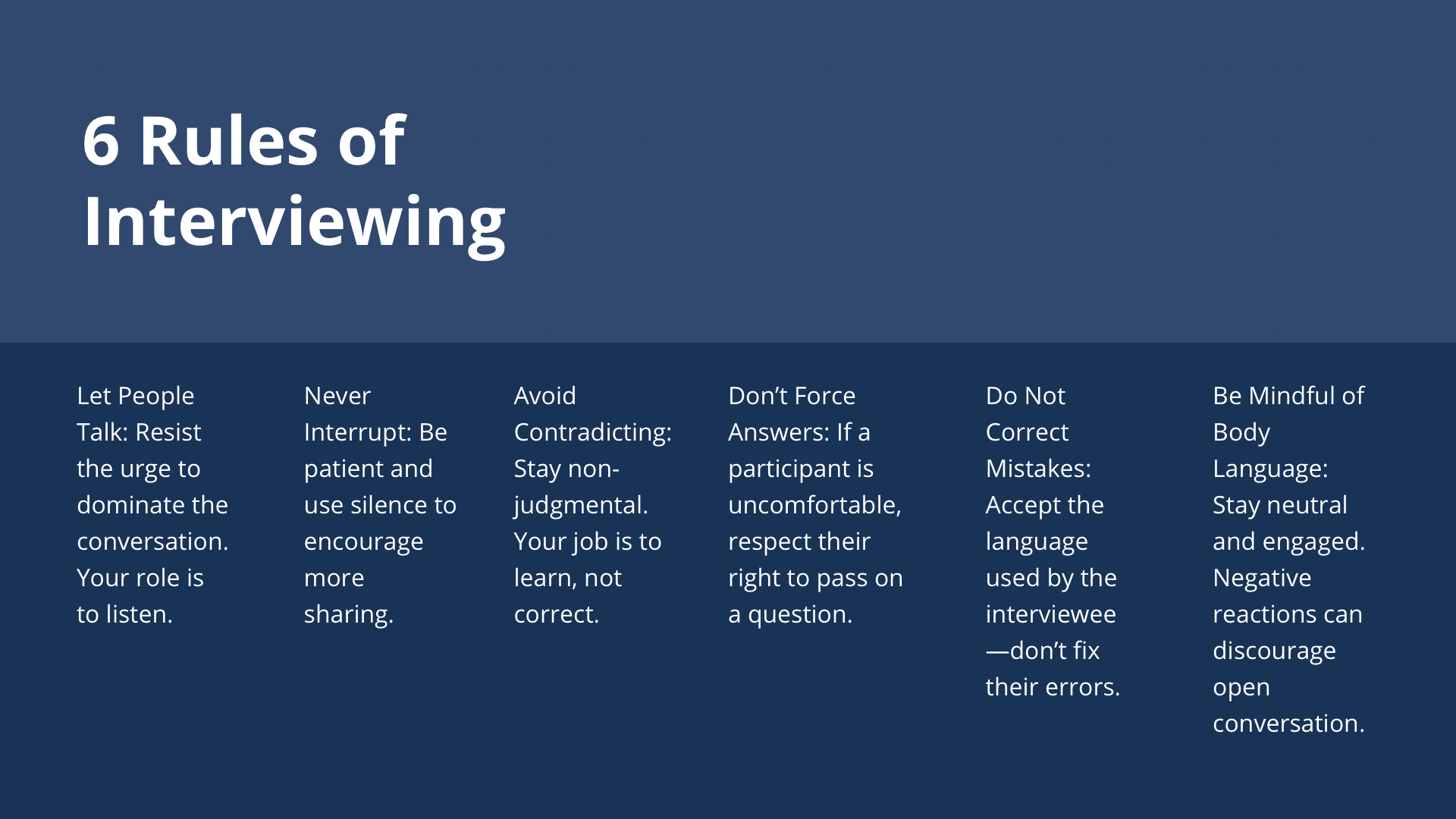Great product managers don’t just make decisions—they uncover insights that drive them!
To build successful products, you need a deep understanding of people: users, stakeholders, team members and the best way to achieve that? Mastering the art of interviewing!
Interviews help you gather customer feedback, align teams, and refine your product vision, but interviewing isn’t just about asking questions—it’s about uncovering what matters.
Why Interviews Matter in Product Research
Interviews are a cornerstone of qualitative research. They allow you to tap into real perceptions, attitudes, and experiences, but effective interviewing requires more than curiosity. You need to:
• Ask the right questions (and avoid the wrong ones).
• Create an environment where people feel comfortable sharing.
• Extract insights that lead to meaningful product decisions.
If you missed [Part I: User Interviews for PM's], check it out for guidance on interview types, when to use them, and how to prepare. Now, let’s dive into advanced techniques for better interviews.
The Challenges of Interviews
Interviews are powerful, but they have limitations:

When to Use Interviews
Interviews are best when you need to understand why people think, feel, or behave a certain way. They uncover perceptions, attitudes, motivations, and decision-making processes—insights that are hard to extract from analytics or surveys alone.
However, interviews rely on self-reported data, which isn’t always accurate. People often misremember past behavior, rationalize decisions after the fact, or tell you what they think you want to hear.
That’s why interviews are most effective when used in these scenarios:
- Early-stage product discovery - Understanding user pain points, unmet needs, and mental models.
- Feature validation - Exploring how users perceive and evaluate a concept before building.
- Understanding churn or adoption Learning why users do or don’t engage with a product.
- Stakeholder alignment Gathering internal perspectives to identify competing priorities.
When NOT to use interviews
If you need insights into actual behavior (rather than perceived behavior), interviews alone aren’t enough.
Consider these alternatives:
- Observation (Usability Testing, Diary Studies, Ethnographic Research) - When you want to see how people naturally interact with a product or environment.
- Behavioral Analytics - When you need quantitative data on what users are actually doing (e.g., tracking feature usage).
- A/B Testing - When you want real-world validation of preferences rather than opinions.
Interviewing Rules to Live By
To conduct meaningful interviews, follow these golden rules:

Probing Techniques for Deeper Insights
Great interviewers know how to dig deeper. Use these techniques:
• Silent Probe – After a question, wait 15 seconds. Silence encourages elaboration.
• Echo Probe – Repeat their last few words to prompt further discussion.
• Paraphrasing – Restate their answer to confirm understanding.
• Tell Me More – Use prompts like “Can you expand on that?” "Anything else" to go deeper.
Recruiting the right participants means success
Recruiting the right participants is the foundation of successful user research. If you’re talking to the wrong people, your insights won’t reflect reality—and worse, you might make product decisions based on misleading data. Imagine designing a product for sports fans but only interviewing people who hate sports. That’s how easy it is to go off track if your participant selection isn’t intentional. So, how do you ensure your research participants truly represent your target users?
Step 1: Define Your Ideal Participant
Demographics alone aren’t enough. Instead, focus on behaviors, motivations, and past actions.
For example, if you’re researching a premium next-day fashion delivery service, your ideal participants should be:
✔️ Buying clothes online at least once a month
✔️ Following fashion influencers on social media
✔️ Previously subscribed to a premium shopping service
Step 2: Find the Right Participants
Recruitment Methods
1. Recruitment Agencies – Quick but expensive ($150++ per recruit).
2. Automated Platforms – Faster but may attract “professional testers.”
3. Internal Customer Panels – Cost-effective but lacks diversity.
4. Online Communities – Engaged users but requires manual effort.
5. Website Pop-ups & Emails – Targets existing users but excludes new ones.
Step 3: Use a Screener Survey
Filter out the wrong participants by focusing on actions, not opinions.
✅ Ask “Have you paid for a premium shipping service in the past 6 months?” instead of “Would you pay for next-day shipping?”
✅ Use open-ended questions to detect cheaters (e.g., “What brands do you wear most often?”).
✅ Avoid leading questions that influence responses.
Step 4: Offer the Right Incentives
Match the incentive to the effort required:
💰 Cash ($50-$200)
🎁 Gift Cards
🛍️ Discounts
👕 Swag
Check ethical guidelines in your industry before offering payments.
Step 5: Ensure Inclusivity
To get truly diverse insights, recruit:
♿ Users who rely on assistive technologies
📱 Screen reader and voice navigation users
🖥️ People with color blindness, dyslexia, or motor impairments
Include accessibility needs in your screener survey.
Step 6: Start Early & Plan for No-Shows
Recruitment takes longer than expected. 10-20% of participants won’t show up.
💡 Pro Tip: Over-recruit slightly (if you need 10 participants, aim for 12).
Final Thoughts: Quality Participants = Quality Insights
The success of your user research hinges on talking to the right people.
✅ Define participant criteria based on behavior, not just demographics.
✅ Use multiple recruitment channels to get a diverse pool.
✅ Screen participants carefully to ensure they match your ideal user.
✅ Offer the right incentives to attract engaged participants.
✅ Start early and over-recruit to account for dropouts.
REMOTE INTERVIEWING: WHAT TO CONSIDER
Virtual interviews are common nowadays, especially after covid. They are obviously convenient, but do come with challenges so make sure to:
1. Choose the Right Format
• Video calls allow for non-verbal cues but respect participants’ preferences—some may prefer voice-only.
• Ensure they’re comfortable with the platform (Google Meet, Zoom, etc.) and send detailed instructions in advance.
2. Overcome Remote Challenges
• Technical Issues – Use reliable tools that don’t require installation.
• Building Rapport – Use body language and eye contact to create a connection.
• Poor Connectivity – Have a backup plan in case of internet issues.
By being aware of the challenges that you can face in interviewing; you can prepare for them. Follow the 6 rules and lean into the probing techniques to create space for great interviews to take place. By taking a strategic approach to recruitment, starting early, screening carefully, with diverse perspectives, you’ll collect more accurate, actionable insights—and ultimately, build better products that deliver on your outcomes.


0 Comments